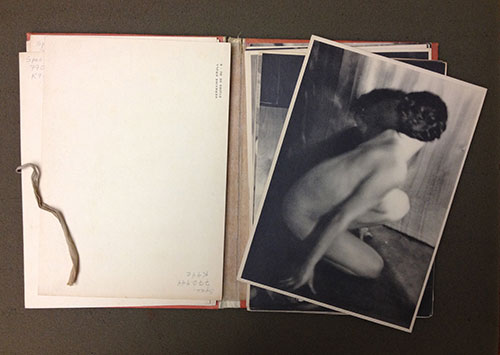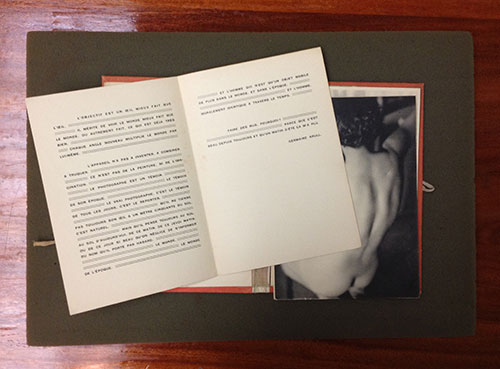| Germaine Krull Book cover for Germaine Krull, Études de nu, (Paris: Librairie des Arts Décoratifs - A. Calavas Éditeur, (1930)) 1930 |
Etudes de nu
Holding a copy of Germaine Krull’s Etudes de nu in your hands is a special event. The book (Librairie des Arts Décoratifs, Paris, 1930) is a rare find, with few copies available in public collections and even fewer coming up for auction. Those that do appear on the block can go for princely sums, some in the neighborhood of $10,000. Given the scarcity of the book, I was quite excited to find a copy just a couple hours away in the Ryerson and Burnham Libraries at the Art Institute of Chicago.
It came as something of a disappointment, then, that as an object, Etudes de nu turned out to be merely curious rather than exceptional.
Yes, the portfolio of 24 loose-leaf sheets is gorgeously printed, and the small size and portfolio format contribute to an overall effect of delicacy and preciousness. However, the images themselves are rather bland, and they fit only very loosely together as a group. Some images feature the elegant curve of the female form from vaguely original angles, all framed very conventionally with a soft and caressing light.
In other photographs, we see Krull’s signature use of strong shadow, in this case appearing behind an awkwardly posed model. In between are a couple of double exposure experiments that only succeed in doubling the awkward. With so little going on, but in so many different directions, Etudes de nuprojects a lack of cohesion that is more confusing than intriguing.

Parr and Badger (Volume 1, p. 78) echo Kim Sichel’s assessment (Germaine Krull: Photographer of Modernity, p. 86) that this series of nudes is a “step backward” from the innovative modernism displayed in Krull’s 1928 masterwork Métal, and even a step back in relation to her earlier work in nudes. Certainly the more Sapphic, and visually interesting, nudes that Krull experimented with in Berlin in the early 1920s show that she was capable of pushing the genre into more original and provoking directions. (You can see these earlier nudes in Sichel’s book.) I’m holding out hopes that Krull’s signature accomplishment, Métal, will be more impressive. —Mary Goodwin
| Germaine Krull Book cover for Germaine Krull "Métal. Introduction by Florent Fels" (Paris: Librairie des Arts Décoratifs, 1928) 1928 |
I looked at a first edition of Etudes de nu at the Ryerson and Burnham Libraries, Art Institute of Chicago. Click here to find a copy of Etudes de nu near you. See also
Dutch Books of Nudes Alessandro Bertolotti Sanne Sannes Anthon Beeke Ed van der Elsken Ginger Gordon Diana Blok Graphic Design Typography Photography
Germaine Krull (1897-1985) led an extraordinary life that spanned nine decades and four continents. She witnessed many of the high points of modernism and recorded some of the major upheavals of the twentieth century. Her photographs include avant-garde montages, ironic studies of female nudes, press propaganda shots, as well as some of the most successful commercial and fashion images of her day. Her political commitments led her from communist allegiance to incarceration in Russia as a counterrevolutionary to support of the Free French cause against Hitler to a reclusive existence among Tibetan monks in India. Kim Sichel's study of this remarkable artist reveals a life of deep convictions, implausible transformations, complex emotional relationships, and inspired achievements.
Krull refused to limit herself to one long-term relationship, one geographical region, or one set of religious and moral beliefs. Contemporary critics ranked her with Man Ray and André Kertesz. Younger photographers such as Berenice Abbott looked up to her. Yet until recently the absence of an archive has made a proper evaluation of Krull's contribution to photography and to modernism difficult if not impossible. In this book Sichel examines Krull's autobiographical texts and photographic oeuvre to present and unravel the rich mythology that Krull fabricated around her life and work. The chapters follow the geographical and chronological sequence of Krull's life, moving from Munich to Moscow to Berlin to Amsterdam to Paris to Brazil to Africa to Bangkok and other locations.
Krull, Germaine. Métal. Paris: Librairie des arts décoratifs, 1928. (New facsimile edition published in 2003 by Ann and Jürgen Wilde, Köln.)
Krull, Germaine. 100 x Paris. Berlin-Westend: Verlag der Reihe, 1929.
Bucovich, Mario von. Paris. New York: Random House, 1930. (With photographs by Krull.)
Colette. La Chatte. Paris: B. Grasset, 1930. (With photographs by Krull.)
Krull, Germaine. Études de Nu. Paris: Librairie des Arts Décoratifs, 1930.
Nerval, Gérard de, and Germaine Krull. Le Valois. Paris: Firmin-Didot, 1930.
Warnod, André. Visages de Paris. Paris: Firmin-Didot, 1930. (With photographs by Krull.)
Krull, Germaine, and Claude Farrère. La Route Paris-Biarritz. Paris: Jacques Haumont, 1931.
Morand, Paul, and Germaine Krull. Route de Paris à la Méditerranée. Paris: Firmin-Didot, 1931.
Krull, Germaine, and André Suarès. Marseille. Paris: Librairie Plon, 1935.
Krull, Germaine, Raúl Lino, and Ruy Ribeiro Couto. Uma Cidade Antiga do Brasil, Ouro Preto. Lisboa: Edições Atlântico, 1943.
Vailland, Roger. La Bataille d’Alsace (Novembre-Décembre 1944). Paris: Jacques Haumont, 1945. (With photographs by Krull.)
Krull, Germaine. Chiengmai. Bangkok: Assumption Printing Press, 1950–1959?
Krull, Germaine, and Dorothea Melchers. Bangkok: Siam’s City of Angels. London: R. Hale, 1964.
Krull, Germaine, and Dorothea Melchers. Tales from Siam. London: R. Hale, 1966.
Krull, Germaine. Tibetans in India. Bombay: Allied Publishers, 1968.
Krull, Germaine. La Vita Conduce la Danza. Firenze: Giunti, 1992. ISBN 88-09-20219-8.
(Unpublished autobiography of Krull in French, La Vie Mène la Danse or “Life Leads the Dance”, translated into Italian by Giovanna Chiti.)

































Geen opmerkingen:
Een reactie posten